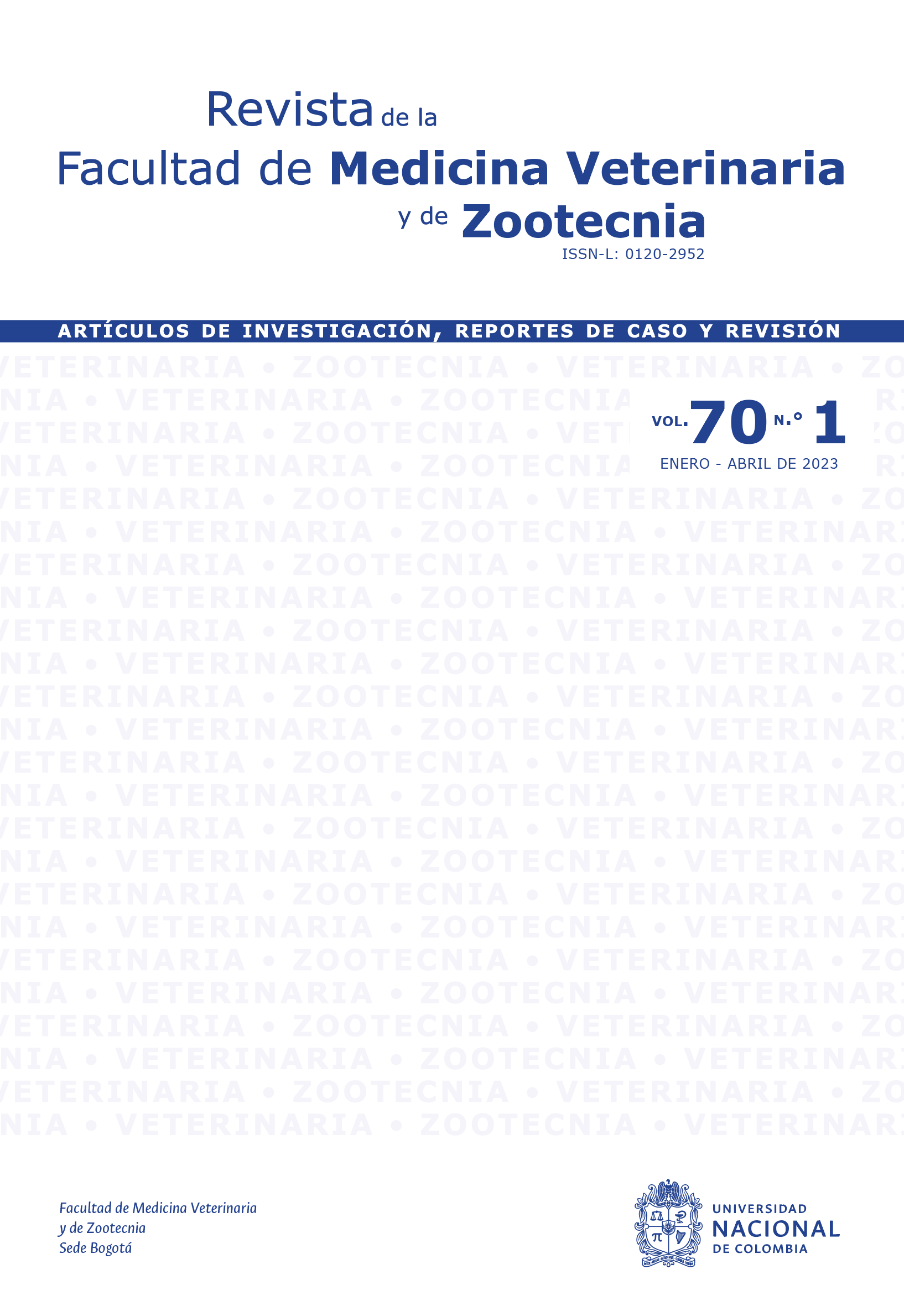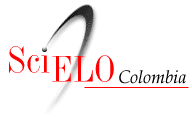Effect of silymarin on oxidative damage in chicken liver cell membranes
Efecto de la silimarina sobre el daño oxidativo en membranas celulares de hígado de pollo
DOI:
https://doi.org/10.15446/rfmvz.v70n1.102246Palabras clave:
silymarin, liver, chicken, chemiluminescence (en)silimarina, hígado, pollo, quimioluminiscencia (es)
Descargas
In living beings, antioxidants are of vital importance for protection against oxidative damage caused by reactive oxygen species. Silymarin (SM), a plant-derived flavonoid present in the fruits and seeds of milk thistle Silybum marianum (L.) Gaertn., has a recognized hepatoprotective effect. In this work, the in vitro silymarin antioxidant effect on non-enzymatic peroxidation (NEP) in chicken liver mitochondria and microsomes was studied. Oxidative stress in the organelles was induced by subjecting the samples (1 mg of protein) to an ascorbate-Fe++-dependent prooxidant system at 37 °C. Oxidative damage was quantified by chemiluminescence (CL) using a Packard1900 TR liquid scintillation counter (Meriden CT, USA). CL expressed as cpm (counts per minute) was read every 10 minutes to establish the course of peroxidation as a function of time. Likewise, the total cpm value (sum of the readings) was used to compare the inhibitory effect of SM using different concentrations corresponding to 6.25; 12.5, and 25 μg of the active ingredient (silymarin phosphatide) per mg of mitochondrial and microsomal protein. Controls were run simultaneously without the addition of ascorbate. Peroxidation inhibition was dependent on the concentration of SM in the incubation mixture. The results show that a protective effect on induced oxidative damage was found for all concentrations tested.
En los seres vivos, los antioxidantes son de vital importancia para la protección contra el daño oxidativo causado por las especies reactivas del oxígeno. La silimarina (SM), un flavonoide de origen vegetal presente en los frutos y semillas del cardo mariano Silybum marianum (L.) Gaertn., tiene un reconocido efecto hepatoprotector. En este trabajo se estudió el efecto antioxidante in vitro de la silimarina sobre la peroxidación no enzimática (PNE) en mitocondrias y microsomas de hígado de pollo. El estrés oxidativo en los orgánulos se indujo sometiendo las muestras (1 mg de proteína) a un sistema prooxidante dependiente de ascorbato-Fe++ a 37 °C. El daño oxidativo se cuantificó por quimioluminiscencia (QL) utilizando un contador de centelleo líquido Packard 1900 TR (Meriden CT, EE. UU.). QL expresado como cpm (recuentos por minuto) se leyó cada 10 minutos para establecer el curso de la peroxidación en función del tiempo. Asimismo, se usó el valor total de cpm (suma de las lecturas) para comparar el efecto inhibitorio de SM mediante diferentes concentraciones correspondientes a 6,25; 12,5 y 25 μg del ingrediente activo (fosfátido de silimarina) por mg de proteína mitocondrial y microsomal. Los controles se realizaron simultáneamente sin la adición de ascorbato. La inhibición de la peroxidación dependía de la concentración de SM en la mezcla de incubación. Los resultados muestran que para todas las concentraciones probadas se encontró un efecto protector sobre el daño oxidativo inducido.
Referencias
Armanini EH, Boiago MM, De Oliveira Cécere BG, Oliveira PV, Teixeira CJS, Strapazzon JV, Bottari NB, Silva AD, Fracasso M, Vendruscolo RG, Wagner R, Da Gloria EM, Horn VW, Mendes RE, Baldissera MD, Vedovatto M, Da Silva AS. 2021. Protective effects of silymarin in broiler feed contaminated by mycotoxins: growth performance, meat antioxidant status, and fatty acid profiles. Trop Anim Health Prod. 53(4):442. https://doi.org/10.1007/s11250-021-02873-2 DOI: https://doi.org/10.1007/s11250-021-02873-2
Detaille D, Pasdois P, Sémont A, Dos Santos P, Diolez P. 2019. An old medicine as a new drug to prevent mitochondrial complex I from producing oxygen radicals. PLoS One. 14(5):e0216385. eCollection 2019. https://doi.org/10.1371/journal.pone.0216385 DOI: https://doi.org/10.1371/journal.pone.0216385
Di Meo S, Venditti P. 2020. Evolution of the knowledge of free radicals and other oxidants. Oxid Med Cell Longev. 2020:9829176. eCollection 2020. https://doi.org/10.1155/2020/9829176 DOI: https://doi.org/10.1155/2020/9829176
Dżugan M, Tomczyk M, Sowa P, Grabek-Lejko D. 2018. Antioxidant activity as biomarker of honey variety. Molecules. 23(8):2069. https://doi.org/10.3390/molecules23082069 DOI: https://doi.org/10.3390/molecules23082069
Federico A, Dallio M, Loguercio C. 2017.Silymarin/Silybin and Chronic Liver Disease: A Marriage of Many Years. Molecules. 22(2):191. https://doi.org/10.3390/molecules22020191 DOI: https://doi.org/10.3390/molecules22020191
Gaschler MM, Stockwell BR. 2017. Lipid peroxidation in cell death. Biochem Biophys Res Commun. 482(3):419-425. https://doi.org/10.1016/j.bbrc.2016.10.086 DOI: https://doi.org/10.1016/j.bbrc.2016.10.086
He L, He T, Farrar S, Ji L, Liu T, Ma X. 2017. Antioxidants maintain cellular redox homeostasis by elimination of reactive oxygen species. Cell Physiol Biochem. 44(2):532-553. https://doi.org/10.1159/000485089 DOI: https://doi.org/10.1159/000485089
Lambrecht J, Van Grunsven LA, Tacke F. 2020. Current and emerging pharmacotherapeutic interventions for the treatment of liver fibrosis. Expert Opin Pharmacother. 21(13):1637-1650. https://doi.org/10.1080/14656566.2020.1774553 DOI: https://doi.org/10.1080/14656566.2020.1774553
Lawrence GD. 2021. Perspective: The Saturated fat-unsaturated oil dilemma: relations of dietary fatty acids and serum cholesterol, atherosclerosis, inflammation, cancer, and all-cause mortality. Adv Nutr. 12(3):647-656. https://doi.org/10.1093/advances/nmab013 DOI: https://doi.org/10.1093/advances/nmab013
Li S, Tan HY, Wang N, Zhang ZJ, Lao L, Wong CW, Feng Y. 2015. The role of oxidative stress and antioxidants in liver diseases. Int J Mol Sci. 16(11):26087-124. https://doi.org/10.3390/ijms161125942 DOI: https://doi.org/10.3390/ijms161125942
Lowry OH, Rosebrough NJ, Farr AL. 1951. Protein measurement with the Folin phenol reagent. J Biol Chem. 193(1):265-75. PMID: 14907713 DOI: https://doi.org/10.1016/S0021-9258(19)52451-6
MacDonald-Ramos K, Michán L, Martínez-Ibarra A, Cerbón M. 2021. Silymarin is an ally against insulin resistance. A review. Ann Hepatol. 23:100255. https://doi.org/10.1016/j.aohep.2020.08.072 DOI: https://doi.org/10.1016/j.aohep.2020.08.072
Maleki SJ, Crespo JF, Cabanillas B. 2019. Anti-inflammatory effects of flavonoids. Food Chem. 299:125124. https://doi.org/10.1016/j.foodchem.2019.125124 DOI: https://doi.org/10.1016/j.foodchem.2019.125124
Marmunti M, Gavazza M, Zeinsteger PA, Palacios A. 2016. Antioxidant Effect of Silymarin During Non-Enzymatic Peroxidation of Rat Kidney Microsomes and Mitochondria. Biochem Mol Biol Lett. 2(1):102. Disponible en: https://www.tsijournals.com/articles/antioxidant-effect-of-silymarin-during-nonenzymatic-peroxidation-of-rat-kidney-microsomes-and-mitochondria.pdf
Oddone N, Pederzoli F, Duskey JT, De Benedictis CA, Grabrucker AM, Forni F, Angela Vandelli M, Ruozi B, Tosi G. 2019. ROS responsive smart polymeric conjugate synthesis characterization and proof of concept study. Int J Pharm. 570:118655. https://doi.org/10.1016/j.ijpharm.2019.118655 DOI: https://doi.org/10.1016/j.ijpharm.2019.118655
Parcheta M, Świsłocka R, Orzechowska S, Akimowicz M, Choińska R , Lewandowski W. 2021. Recent Developments in Effective Antioxidants: The Structure and Antioxidant Properties. Materials (Basel). 14(8):1984. https://doi.org/10.3390/ma14081984 DOI: https://doi.org/10.3390/ma14081984
Rajnochová Svobodová A, Zálešák B, Biedermann D, Ulrichová J, Vostálová J. 2016. Phototoxic potential of silymarin and its bioactive components. J Photochem Photobiol B. 156:61-8. https://doi.org/10.1016/j.jphotobiol.2016.01.011 DOI: https://doi.org/10.1016/j.jphotobiol.2016.01.011
Rauchová H, Kalous M, Drahota Z, Koudelová J, Mourek J.1993. Lipid peroxidation in isolated membranes of cerebral cortex, heart, and kidney. Physiol Res. 42(5):323-7. PMID: 8130178. Disponible en: http://www.biomed.cas.cz/physiolres/pdf/42/42_323.pdf
Saeed M, Babazadeh D, Arif M, Arain MA, Bhutto ZA, Shar AH, Kakar MU, Manzoor R, Chao S. 2019. Silymarin: a potent hepatoprotective agent in poultry industry. Worlds Poult Sci J. 73:483-492. https://doi.org/10.1017/S0043933917000538 DOI: https://doi.org/10.1017/S0043933917000538
Schneider WC, Hogeboom GH. 1951. Cytochemical studies of mammalian tissues; the isolation of cell components by differential centrifugation: a review. Cancer Res. 11(1):1-22. PMID: 14792549. Disponible en: https://aacrjournals.org/cancerres/article/11/1/1/472487/Cytochemical-Studies-of-Mammalian-Tissues-The
Su LJ, Zhang JH, Gomez H, Murugan R, Hong X, Xu D, Jiang F, Peng ZY. 2019. Reactive oxygen species induced lipid peroxidation in apoptosis, autophagy, and ferroptosis. Oxid Med Cell Longev. 2019:5080843. https://doi.org/10.1155/2019/5080843 DOI: https://doi.org/10.1155/2019/5080843
Surai PF. 2015. Silymarin as a natural antioxidant: an overview of the current evidence and perspectives. antioxidants. Basel. 4(1):204-47. https://doi.org/10.3390/antiox4010204 DOI: https://doi.org/10.3390/antiox4010204
Tadolini B, Hakim G. 1996. The mechanism of iron (III) stimulation of lipid peroxidation. Free Radic Res. 25(3):221-7. https://doi.org/10.3109/10715769609149047 DOI: https://doi.org/10.3109/10715769609149047
Tangen O, Jonsson J, Orrenius S. 1973. Isolation of rat liver microsomes by gel filtration. Anal Biochem. 54:597-603. https://doi.org/10.1016/0003-2697(73)90392-8 DOI: https://doi.org/10.1016/0003-2697(73)90392-8
Trefts E, Gannon M, Wasserman DH. 2017. The liver. Curr Biol. 27(21):R1147-R1151. https://doi.org/10.1016/j.cub.2017.09.019 DOI: https://doi.org/10.1016/j.cub.2017.09.019
Van Hung P. 2016. Phenolic compounds of cereals and their Antioxidant capacity. Crit Rev Food Sci Nutr. 56(1):25-35. https://doi.org/10.1080/10408398.2012.708909 DOI: https://doi.org/10.1080/10408398.2012.708909
Wright JR, Rumbaugh RC, Colby HD. 1979. The relationship between chemiluminescence and lipid peroxidation in rat hepatic microsomes. Arch Biochem Biophys. 192(2):344-51. https://doi.org/10.1016/0003-9861(79)90102-4 DOI: https://doi.org/10.1016/0003-9861(79)90102-4
Xu T, Yue K, Zhang C, Tong X, Lin L, Cao Q, Huang S. 2021. Probiotics treatment of leg diseases in broiler chickens: a review. Probiotics Antimicrob Proteins. https://doi.org/10.1007/s12602-021-09869-2 DOI: https://doi.org/10.1007/s12602-021-09869-2
Zeb AJ. 2020. Concept, mechanism, and applications of phenolic antioxidants in foods. J Food Biochem. 44(9):e13394. https://doi.org/10.1111/jfbc.13394 DOI: https://doi.org/10.1111/jfbc.13394
Zhao H, Huang J, Li Y, Lv X, Zhou H, Wang H, Xu Y, Wang C, Wang J, Liu Z. 2020. ROS- scavenging hydrogel to promote healing of bacteria-infected diabetic wounds. Biomaterials. 258:120286. https://doi.org/10.1016/j.biomaterials.2020.120286 DOI: https://doi.org/10.1016/j.biomaterials.2020.120286
Zhong S, Li L, Shen X, Li Q, Xu W, Wang X, Tao Y, Yin H. 2019. An update on lipid oxidation and inflammation in cardiovascular diseases. Free Radic Biol Med. 144:266–78. https://doi.org/10.1016/j.freeradbiomed.2019.03.036 DOI: https://doi.org/10.1016/j.freeradbiomed.2019.03.036
Cómo citar
APA
ACM
ACS
ABNT
Chicago
Harvard
IEEE
MLA
Turabian
Vancouver
Descargar cita
Licencia
Derechos de autor 2023 Revista de la Facultad de Medicina Veterinaria y de Zootecnia

Esta obra está bajo una licencia internacional Creative Commons Atribución-NoComercial-SinDerivadas 4.0.
Aquellos autores/as que tengan publicaciones con esta revista, aceptan los términos siguientes:
a) Los autores/as conservarán sus derechos de autor y de publicación y garantizarán a la revista el derecho de primera publicación de su obra, el cuál estará simultáneamente sujeto a la Licencia de reconocimiento de Creative Commons que permite a terceros compartir la obra siempre que se indique su autor y su primera publicación esta revista.
b) Los autores/as podrán adoptar otros acuerdos de licencia no exclusiva de distribución de la versión de la obra publicada (p. ej.: depositarla en un archivo telemático institucional o publicarla en un volumen monográfico) siempre que se indique la publicación inicial en esta revista.
c) Se permite y recomienda a los autores/as difundir su obra a través de Internet (p. ej.: en archivos telemáticos institucionales o en su página web) antes y durante el proceso de envío, lo cual puede producir intercambios interesantes y aumentar las citas de la obra publicada. (Véase El efecto del acceso abierto).
d) Las tablas y figuras que no indiquen en su parte inferior la fuente de la información se consideran resultados del estudio que está siendo publicado, es decir, que fueron elaborados por los autores del manuscrito basados en la información obtenida y procesada en la investigación, reporte de caso, etc que está siendo publicado.
AUTORIZACIÓN DE PUBLICACIÓN Y ACUERDO EDITORIAL
Una vez sometidos los manuscritos, los autores/as confieren a la dirección editorial de la Revista de la Facultad de Medicina Veterinaria y de Zootecnia en su versión impresa (ISSN 0120-2952) y en su versión online (ISNN 2357-3813) autorización para su publicación de acuerdo con los siguientes criterios:
a) Somos los autores/as intelectuales del manuscrito, que éste es inédito, es decir, que no ha sido remitido, aceptado o publicado en otras revistas o publicaciones técnico-científicas impresas ni electrónicas y aceptamos que sea publicado en la Revista de la Facultad de Medicina Veterinaria y de Zootecnia en caso de ser aprobado.
b) El contenido total o parcial del manuscrito remitido no será sometido para su publicación en otra(s) revista(s) durante la duración de los procesos de evaluación por pares y edición de la Revista de la Facultad de Medicina Veterinaria y de Zootecnia.
c) Todos los autores/as han leído la versión definitiva del artículo presentado y se hacen responsables por todos los conceptos e información de texto e imágenes allí contenidos ante la Universidad Nacional de Colombia y ante terceros. La dirección editorial de la Revista no se hace responsable por la veracidad y autenticidad de dicha información, ni será responsable de dirimir conflictos relacionados con la autoría del manuscrito.
d) El artículo sometido a consideración del Comité Editorial de la Revista de la Facultad de Medicina Veterinaria y de Zootecnia cumple las normas establecidas en la política de publicación y las instrucciones a los autores. En caso contrario el manuscrito será rechazado hasta no haber acogido la totalidad de la normativa de presentación de manuscritos.
e) Los autores/as se dan por informados que el proceso de arbitraje y edición del artículo puede tomar varios meses y que su recepción no implica ni la aprobación ni la publicación del mismo.
f) Una vez terminado el proceso de evaluación los autores/as se comprometen a atender y consolidar, estrictamente en los plazos de tiempo establecidos por el editor, todas las observaciones, correcciones o sugerencias hechas por los pares evaluadores del artículo y por el editor. Durante el proceso de corrección de estilo y edición, se verificará la consolidación de las observaciones de los evaluadores, razón por la cual, en caso de encontrar que no han sido integradas al documento, éste no será publicado hasta que sus autores no las consoliden; sin embargo, en caso de que alguna(s) de las correcciones formuladas por los pares evaluadores no puedan ser adicionadas a la versión definitiva del artículo, los autores podrán sustentar sus razones al editor de la revista en el oficio de remisión del artículo definitivo.
g) La totalidad de los autores/as aprueba la publicación del documento completo en sus versiones impresa y digital, lo que incluye las diferentes bases de datos en los que la Revista es y será incluida para promover su visibilidad.
h) Los autores/as conocen que la autorización incluye la posibilidad para la Revista de comercializar la publicación a través de los canales tradicionales y de Internet, o cualquier otro medio conocido, y aceptan que la autorización de publicación se hace a título gratuito, por lo tanto renuncian a recibir remuneración alguna por la publicación, distribución, comunicación pública y cualquier otro uso que se haga en los términos en que la obra es publicada.
i) La Revista se compromete a indicar siempre la autoría de sus contenidos incluyendo el nombre de los autores/as y la fecha de publicación. De igual forma, los autores/as se comprometen a citar los trabajos publicados en esta publicación de acuerdo con los estándares internacionales de citación, incluyendo el nombre completo o abreviado de la Revista (Rev Med Vet Zoot.).

























